Performance and Antiwear Mechanism of 1D and 2D Nanoparticles as Additives in a Polyalphaolefin
Abstract
:1. Introduction
2. Materials and Methods
2.1. Materials
2.1.1. Base Oil
2.1.2. Nanoadditives
2.2. Design and Stability of the Nanolubricants
2.3. Thermophysical Characterization
2.4. Wettability
2.5. Tribological Assays
3. Results
3.1. Stability Assessment of Nanolubricants
3.2. Thermophysical Properties
3.3. Wetting Behavior
3.4. Tribological Performance
3.5. Anti-Friction and Antiwear Mechanisms
4. Conclusions
Supplementary Materials
Author Contributions
Funding
Data Availability Statement
Acknowledgments
Conflicts of Interest
References
- Zhang, M.; Wang, X.; Liu, W. Tribological Behavior of LaF3 Nanoparticles as Additives in Poly-alpha-olefin. Ind. Lubr. Tribol. 2013, 65, 226–235. [Google Scholar] [CrossRef]
- Alqahtani, B.; Hoziefa, W.; Abdel Moneam, H.M.; Hamoud, M.; Salunkhe, S.; Elshalakany, A.B.; Abdel-Mottaleb, M.; Davim, J.P. Tribological Performance and Rheological Properties of Engine Oil with Graphene Nano-Additives. Lubricants 2022, 10, 137. [Google Scholar] [CrossRef]
- González, R.; Viesca, J.L.; Battez, A.H.; Hadfield, M.; Fernández-González, A.; Bartolomé, M. Two Phosphonium Cation-Based Ionic Liquids as Lubricant Additive to a Polyalphaolefin Base Oil. J. Mol. Liq. 2019, 293, 111536. [Google Scholar] [CrossRef]
- Wu, Y.Y.; Tsui, W.C.; Liu, T.C. Experimental Analysis of Tribological Properties of Lubricating Oils with Nanoparticle Additives. Wear 2007, 262, 819–825. [Google Scholar] [CrossRef]
- Rudnick, L.R. Polyalphaolefins. In Synthetics, Mineral Oils, and Bio-Based Lubricants; Rudnick, L.R., Ed.; CRC Press: Boca Raton, FL, USA, 2020. [Google Scholar]
- Moore, L.D.; Fels, D.R.; Seay, A.B.; Lopez, C.; Harris, K.E.; Peck, D.A. PAO-Based Synthetic Lubricants in Industrial Applications. Lubr. Eng. 2003, 59, 23–30. [Google Scholar] [CrossRef]
- Opia, A.C.; Kameil, M.; Hamid, A.; Johnson, C.A.N.; Chukwunonso Opia, A.; Rahim, A.B.; Abdulrahman, M.B. Nano-Particles Additives as a Promising Trend in Tribology: A Review on Their Fundamentals and Mechanisms on Friction and Wear Reduction. Evergreen 2021, 8, 777–798. [Google Scholar] [CrossRef]
- Demas, N.G.; Timofeeva, E.V.; Routbort, J.L.; Fenske, G.R. Tribological Effects of BN and MoS 2 Nanoparticles Added to Polyalphaolefin Oil in Piston Skirt/Cylinder Liner Tests. Tribol. Lett. 2012, 47, 91–102. [Google Scholar] [CrossRef]
- Zhao, J.; Huang, Y.; He, Y.; Shi, Y. Nanolubricant Additives: A Review. Friction 2020, 9, 891–917. [Google Scholar] [CrossRef]
- Zhou, O.; Shimoda, H.; Gao, B.; Oh, S.; Fleming, L.; Yue, G. Materials Science of Carbon Nanotubes: Fabrication, Integration, and Properties of Macroscopic Structures of Carbon Nanotubes. Acc. Chem. Res. 2002, 35, 1045–1053. [Google Scholar] [CrossRef]
- Moghadam, A.D.; Omrani, E.; Menezes, P.L.; Rohatgi, P.K. Mechanical and Tribological Properties of Self-Lubricating Metal Matrix Nanocomposites Reinforced by Carbon Nanotubes (CNTs) and Graphene—A Review. Compos. B Eng. 2015, 77, 402–420. [Google Scholar] [CrossRef]
- Rahman, M.M.; Islam, M.; Roy, R.; Younis, H.; AlNahyan, M.; Younes, H. Carbon Nanomaterial-Based Lubricants: Review of Recent Developments. Lubricants 2022, 10, 281. [Google Scholar] [CrossRef]
- Zhang, L.; Pu, J.; Wang, L.; Xue, Q. Frictional Dependence of Graphene and Carbon Nanotube in Diamond-like Carbon/Ionic Liquids Hybrid Films in Vacuum. Carbon N. Y. 2014, 80, 734–745. [Google Scholar] [CrossRef]
- Thampi, A.D.; Prasanth, M.A.; Anandu, A.P.; Sneha, E.; Sasidharan, B.; Rani, S. The Effect of Nanoparticle Additives on the Tribological Properties of Various Lubricating Oils—Review. Mater. Today Proc. 2021, 47, 4919–4924. [Google Scholar] [CrossRef]
- Martin, J.M.; Ohmae, N. Nanolubricants; John Wiley & Sons: New York, NY, USA, 2008. [Google Scholar]
- Kimura, Y.; Wakabayashi, T.; Okada, K.; Wada, T.; Nishikawa, H. Boron Nitride as a Lubricant Additive. Wear 1999, 232, 199–206. [Google Scholar] [CrossRef]
- Çelik, O.N.; Ay, N.; Göncü, Y. Effect of Nano Hexagonal Boron Nitride Lubricant Additives on the Friction and Wear Properties of AISI 4140 Steel. Particul. Sci. Technol. 2013, 31, 501–506. [Google Scholar] [CrossRef]
- Dassenoy, F. Nanoparticles as Additives for the Development of High Performance and Environmentally Friendly Engine Lubricants. Tribol. Online 2019, 14, 237–253. [Google Scholar] [CrossRef]
- Kalin, M.; Kogovšek, J.; Remškar, M. Mechanisms and Improvements in the Friction and Wear Behavior Using MoS2 Nanotubes as Potential Oil Additives. Wear 2012, 280–281, 36–45. [Google Scholar] [CrossRef]
- Chou, R.; Battez, A.H.; Cabello, J.J.; Viesca, J.L.; Osorio, A.; Sagastume, A. Tribological Behavior of Polyalphaolefin with the Addition of Nickel Nanoparticles. Tribol. Int. 2010, 43, 2327–2332. [Google Scholar] [CrossRef]
- Hernandez Battez, A.; Fernandez Rico, J.E.; Navas Arias, A.; Viesca Rodriguez, J.L.; Chou Rodriguez, R.; Diaz Fernandez, J.M. The Tribological Behaviour of ZnO Nanoparticles as an Additive to PAO6. Wear 2006, 261, 256–263. [Google Scholar] [CrossRef]
- Alves, S.M.; Barros, B.S.; Trajano, M.F.; Ribeiro, K.S.B.; Moura, E. Tribological Behavior of Vegetable Oil-Based Lubricants with Nanoparticles of Oxides in Boundary Lubrication Conditions. Tribol. Int. 2013, 65, 28–36. [Google Scholar] [CrossRef]
- Mariño, F.; López, E.R.; Arnosa, Á.; González Gómez, M.A.; Piñeiro, Y.; Rivas, J.; Alvarez-Lorenzo, C.; Fernández, J. ZnO Nanoparticles Coated with Oleic Acid as Additives for a Polyalphaolefin Lubricant. J. Mol. Liq. 2022, 348, 118401. [Google Scholar] [CrossRef]
- Liñeira del Río, J.M.; Fernandes, C.M.C.G.; Seabra, J.H.O. Tribological Improvement of Low-Viscosity Nanolubricants: MoO3, MoS2, WS2 and WC Nanoparticles as Additives. Lubricants 2024, 12, 87. [Google Scholar] [CrossRef]
- Liñeira del Río, J.M.; Fernandes, C.M.C.G.; Gonçalves, D.E.P.; Seabra, J.H.O. Synergistic Effects of Functionalized WS2 and SiO2 Nanoparticles and a Phosphonium Ionic Liquid as Hybrid Additives of Low-Viscosity Lubricants. Lubricants 2024, 12, 58. [Google Scholar] [CrossRef]
- Mariño, F.; Liñeira del Río, J.M.; Gonçalves, D.E.P.; Seabra, J.H.O.; López, E.R.; Fernández, J. Effect of the Addition of Coated SiO2 Nanoparticles on the Tribological Behavior of a Low-Viscosity Polyalphaolefin Base Oil. Wear 2023, 530–531, 205025. [Google Scholar] [CrossRef]
- Liñeira del Río, J.M.; Alba, A.; Guimarey, M.J.G.; Prado, J.I.; Amigo, A.; Fernández, J. Surface Tension, Wettability and Tribological Properties of a Low Viscosity Oil Using CaCO3 and CeF3 Nanoparticles as Additives. J. Mol. Liq. 2023, 391, 123188. [Google Scholar] [CrossRef]
- Liñeira del Río, J.M.; Mariño, F.; López, E.R.; Gonçalves, D.E.P.; Seabra, J.H.O.; Fernández, J. Tribological Enhancement of Potential Electric Vehicle Lubricants Using Coated TiO2 Nanoparticles as Additives. J. Mol. Liq. 2023, 371, 121097. [Google Scholar] [CrossRef]
- Jeng, Y.R.; Huang, Y.H.; Tsai, P.C.; Hwang, G.L. Tribological Properties of Carbon Nanocapsule Particles as Lubricant Additive. J. Tribol. 2014, 136, 0418011–0418019. [Google Scholar] [CrossRef] [PubMed]
- Jeng, Y.R.; Huang, Y.H.; Tsai, P.C.; Hwang, G.L. Tribological Performance of Oil-Based Lubricants with Carbon-Fe Nanocapsules Additive. Tribol. Trans. 2015, 58, 924–929. [Google Scholar] [CrossRef]
- Bukvić, M.; Gajević, S.; Skulić, A.; Savić, S.; Ašonja, A.; Stojanović, B. Tribological Application of Nanocomposite Additives in Industrial Oils. Lubricants 2024, 12, 6. [Google Scholar] [CrossRef]
- Kumar, H.; Harsha, A.P. Investigation on Friction, Antiwear, and Extreme Pressure Properties of Different Grades of Polyalphaolefins with Functionalized Multi-Walled Carbon Nanotubes as an Additive. J. Tribol. 2020, 142, 081702. [Google Scholar] [CrossRef]
- Kumar, H.; Harsha, A.P. Augmentation in Tribological Performance of Polyalphaolefins by COOH-Functionalized Multiwalled Carbon Nanotubes as an Additive in Boundary Lubrication Conditions. J. Tribol. 2021, 143, 102202. [Google Scholar] [CrossRef]
- Liñeira del Río, J.M.; López, E.R.; Fernández, J. Tribological Properties of Graphene Nanoplatelets or Boron Nitride Nanoparticles as Additives of a Polyalphaolefin Base Oil. J. Mol. Liq. 2021, 333, 115911. [Google Scholar] [CrossRef]
- Xia, R.; Lou, D.; Younes, H.; Haiston, J.; Chen, H.; Hong, H. Synergistic Effect of Hexagonal Boron Nitride and Carbon Nanofibers on Tribological Behavior of Nanolubricant. Tribol. Int. 2023, 177, 107957. [Google Scholar] [CrossRef]
- Jiang, H.; Hou, X.; Su, D.; Liu, H.; Ali, M.K.A. Elucidation of the Thermophysical Mechanism of Hexagonal Boron Nitride as Nanofluids Additives. Adv. Powder Technol. 2021, 32, 2816–2827. [Google Scholar] [CrossRef]
- Nasser, K.I.; Liñeira del Río, J.M.; López, E.R.; Fernández, J. Synergistic Effects of Hexagonal Boron Nitride Nanoparticles and Phosphonium Ionic Liquids as Hybrid Lubricant Additives. J. Mol. Liq. 2020, 311, 113343. [Google Scholar] [CrossRef]
- Nasser, K.I.; Liñeira del Río, J.M.; Mariño, F.; López, E.R.; Fernández, J. Double Hybrid Lubricant Additives Consisting of a Phosphonium Ionic Liquid and Graphene Nanoplatelets/Hexagonal Boron Nitride Nanoparticles. Tribol. Int. 2021, 163, 107189. [Google Scholar] [CrossRef]
- Nasser, K.I.; Liñeira del Río, J.M.; López, E.R.; Fernández, J. Hybrid Combinations of Graphene Nanoplatelets and Phosphonium Ionic Liquids as Lubricant Additives for a Polyalphaolefin. J. Mol. Liq. 2021, 336, 116266. [Google Scholar] [CrossRef]
- Ziyamukhamedova, U.; Wasil, S.; Kumar, S.; Sehgal, R.; Wani, M.F.; Singh, C.S.; Tursunov, N.; Gupta, H.S. Investigating Friction and Antiwear Characteristics of Organic and Synthetic Oils Using H-BN Nanoparticle Additives: A Tribological Study. Lubricants 2024, 12, 27. [Google Scholar] [CrossRef]
- AbuShanab, Y.; Al-Ammari, W.A.; Gowid, S.; Sleiti, A.K. Accurate Prediction of Dynamic Viscosity of Polyalpha-Olefin Boron Nitride Nanofluids Using Machine Learning. Heliyon 2023, 9, e16716. [Google Scholar] [CrossRef] [PubMed]
- Coelho de Sousa Marques, M.A.; Guimarey, M.J.G.; Domínguez-Arca, V.; Amigo, A.; Fernández, J. Heat Capacity, Density, Surface Tension, and Contact Angle for Polyalphaolefins and Ester Lubricants. Thermochim. Acta 2021, 703, 178994. [Google Scholar] [CrossRef]
- Guimarey, M.J.G.; Comuñas, M.J.P.; López, E.R.; Amigo, A.; Fernández, J. Thermophysical Properties of Polyalphaolefin Oil Modified with Nanoadditives. J. Chem. Thermodyn. 2019, 131, 192–205. [Google Scholar] [CrossRef]
- Liñeira del Río, J.M.; López, E.R.; Fernández, J.; García, F. Tribological Properties of Dispersions Based on Reduced Graphene Oxide Sheets and Trimethylolpropane Trioleate or PAO 40 Oils. J. Mol. Liq. 2019, 274, 568–576. [Google Scholar] [CrossRef]
- Praveena, M.; Guha, K.; Ravishankar, A.; Biswas, S.K.; Bain, C.D.; Jayaram, V. Total Internal Reflection Raman Spectroscopy of Poly(Alpha-Olefin) Oils in a Lubricated Contact. RSC Adv. 2014, 4, 22205–22213. [Google Scholar] [CrossRef]
- Okubo, H.; Tadokoro, C.; Hirata, Y.; Sasaki, S. In Situ Raman Observation of the Graphitization Process of Tetrahedral Amorphous Carbon Diamond-Like Carbon under Boundary Lubrication in Poly-Alpha-Olefin with an Organic Friction Modifier. Tribol. Online 2017, 12, 229–237. [Google Scholar] [CrossRef]
- Rouhani, M.; Hobley, J.; Ou, H.H.; Lee, J.T.; Metla, S.B.S.; Jeng, Y.R. A New Gateway to Ecofriendly Self-Healing Amorphous Carbon Tribofilms from Ancient Oils. Appl. Mater. Today 2022, 29, 101616. [Google Scholar] [CrossRef]
- Liñeira del Río, J.M.; Guimarey, M.J.G.; Comuñas, M.J.P.; López, E.R.; Prado, J.I.; Lugo, L.; Fernández, J. Tribological and Thermophysical Properties of Environmentally-Friendly Lubricants Based on Trimethylolpropane Trioleate with Hexagonal Boron Nitride Nanoparticles as an Additive. Coatings 2019, 9, 509. [Google Scholar] [CrossRef]
- Ţucureanu, V.; Matei, A.; Avram, A.M. FTIR Spectroscopy for Carbon Family Study. Crit. Rev. Anal. Chem. 2016, 46, 502–520. [Google Scholar] [CrossRef] [PubMed]
- Dresselhaus, M.S.; Jorio, A.; Hofmann, M.; Dresselhaus, G.; Saito, R. Perspectives on Carbon Nanotubes and Graphene Raman Spectroscopy. Nano Lett. 2010, 10, 751–758. [Google Scholar] [CrossRef]
- Logeswari, J.; Pandurangan, A.; Sangeetha, D. An Efficient Catalyst for the Large Scale Production of Multi-Walled Carbon Nanotubes. Ind. Eng. Chem. Res. 2011, 50, 13347–13354. [Google Scholar] [CrossRef]
- Gaciño, F.M.; Regueira, T.; Lugo, L.; Comuñas, M.J.P.; Fernández, J. Influence of Molecular Structure on Densities and Viscosities of Several Ionic Liquids. J. Chem. Eng. Data 2011, 56, 4984–4999. [Google Scholar] [CrossRef]
- Liñeira del Río, J.M.; López, E.R.; Fernández, J. Synergy between Boron Nitride or Graphene Nanoplatelets and Tri(Butyl)Ethylphosphonium Diethylphosphate Ionic Liquid as Lubricant Additives of Triisotridecyltrimellitate Oil. J. Mol. Liq. 2020, 301, 112442. [Google Scholar] [CrossRef]
- Guimarey, M.J.G.; Salgado, M.R.; Comuñas, M.J.P.; López, E.R.; Amigo, A.; Cabaleiro, D.; Lugo, L.; Fernández, J. Effect of ZrO2 Nanoparticles on Thermophysical and Rheological Properties of Three Synthetic Oils. J. Mol. Liq. 2018, 262, 126–138. [Google Scholar] [CrossRef]
- Pourpasha, H.; Zeinali Heris, S.; Mahian, O.; Wongwises, S. The Effect of Multi-Wall Carbon Nanotubes/Turbine Meter Oil Nanofluid Concentration on the Thermophysical Properties of Lubricants. Powder Technol. 2020, 367, 133–142. [Google Scholar] [CrossRef]
- Wu, H.; Jia, F.; Li, Z.; Lin, F.; Huo, M.; Huang, S.; Sayyar, S.; Jiao, S.; Huang, H.; Jiang, Z. Novel Water-Based Nanolubricant with Superior Tribological Performance in Hot Steel Rolling. Int. J. Extrem. Manuf. 2020, 2, 025002. [Google Scholar] [CrossRef]
- Morshed, A.; Wu, H.; Jiang, Z. A Comprehensive Review of Water-Based Nanolubricants. Lubricants 2021, 9, 89. [Google Scholar] [CrossRef]
- Hamrock, B.J.; Dowson, D.; Wiley, J.; Sons, N.Y.; Tallian, T.E. Ball Bearing Lubrication (The Elastohydrodynamics of Elliptical Contacts). J. Lubr. Technol. 1982, 104, 279–281. [Google Scholar] [CrossRef]
- Gold, P.W.; Schmidt, A.; Dicke, H.; Loos, J.; Assmann, C. Viscosity–Pressure–Temperature Behaviour of Mineral and Synthetic Oils. J. Synth. Lubr. 2001, 18, 51–79. [Google Scholar] [CrossRef]
- Abdelbary, A.; Chang, L. Lubrication and Surface Engineering. In Principles of Engineering Tribology; Academic Press: Cambridge, MA, USA, 2023; pp. 295–343. ISBN 978-0-323-99115-5. [Google Scholar]
- Ye, X.; E, S.; Fan, M. The Influences of Functionalized Carbon Nanotubes as Lubricating Additives: Length and Diameter. Diam. Relat. Mater. 2019, 100, 107548. [Google Scholar] [CrossRef]
- Joly-Pottuz, L.; Ohmae, N. Carbon-Based Nanolubricants. In Nanolubricants; John Wiley & Sons, Ltd.: Hoboken, NJ, USA, 2008; pp. 93–147. ISBN 9780470065525. [Google Scholar]
- Ali, I.; Basheer, A.A.; Kucherova, A.; Memetov, N.; Pasko, T.; Ovchinnikov, K.; Pershin, V.; Kuznetsov, D.; Galunin, E.; Grachev, V.; et al. Advances in Carbon Nanomaterials as Lubricants Modifiers. J. Mol. Liq. 2019, 279, 251–266. [Google Scholar] [CrossRef]
- Lijesh, K.P.; Muzakkir, S.M.; Hirani, H. Experimental Tribological Performance Evaluation of Nano Lubricant Using Multi-Walled Carbon Nano-Tubes (MWCNT). Int. J. Appl. Eng. Res. 2015, 10, 14543–14551. [Google Scholar]
- Nyholm, N.; Espallargas, N. Functionalized Carbon Nanostructures as Lubricant Additives—A Review. Carbon N. Y. 2023, 201, 1200–1228. [Google Scholar] [CrossRef]
- Tang, J.; Chen, S.; Jia, Y.; Ma, Y.; Xie, H.; Quan, X.; Ding, Q. Carbon Dots as an Additive for Improving Performance in Water-Based Lubricants for Amorphous Carbon (a-C) Coatings. Carbon N. Y. 2020, 156, 272–281. [Google Scholar] [CrossRef]
- Charoo, M.S.; Wani, M.F. Tribological Properties of H-BN Nanoparticles as Lubricant Additive on Cylinder Liner and Piston Ring. Lubr. Sci. 2017, 29, 241–254. [Google Scholar] [CrossRef]
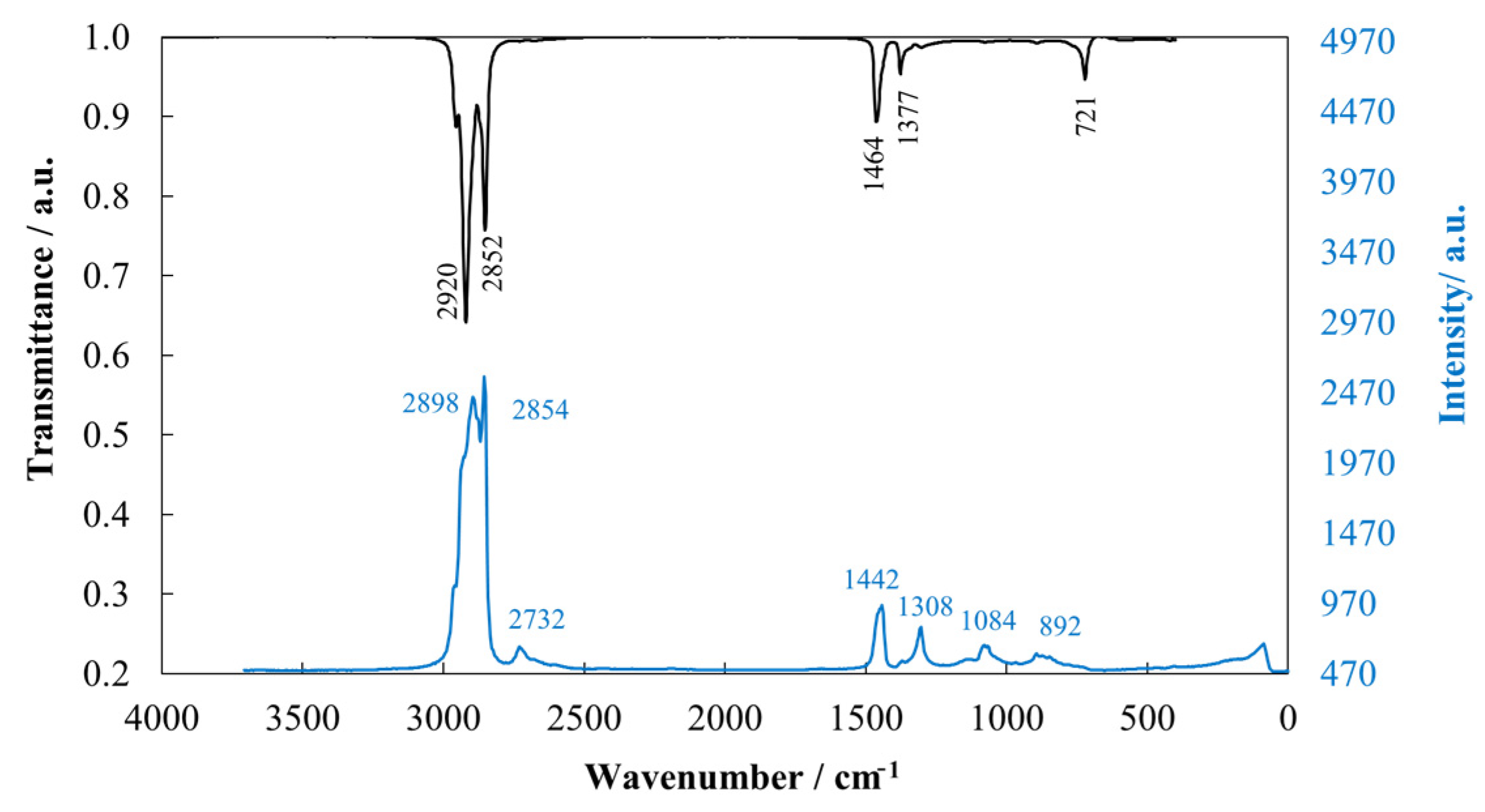

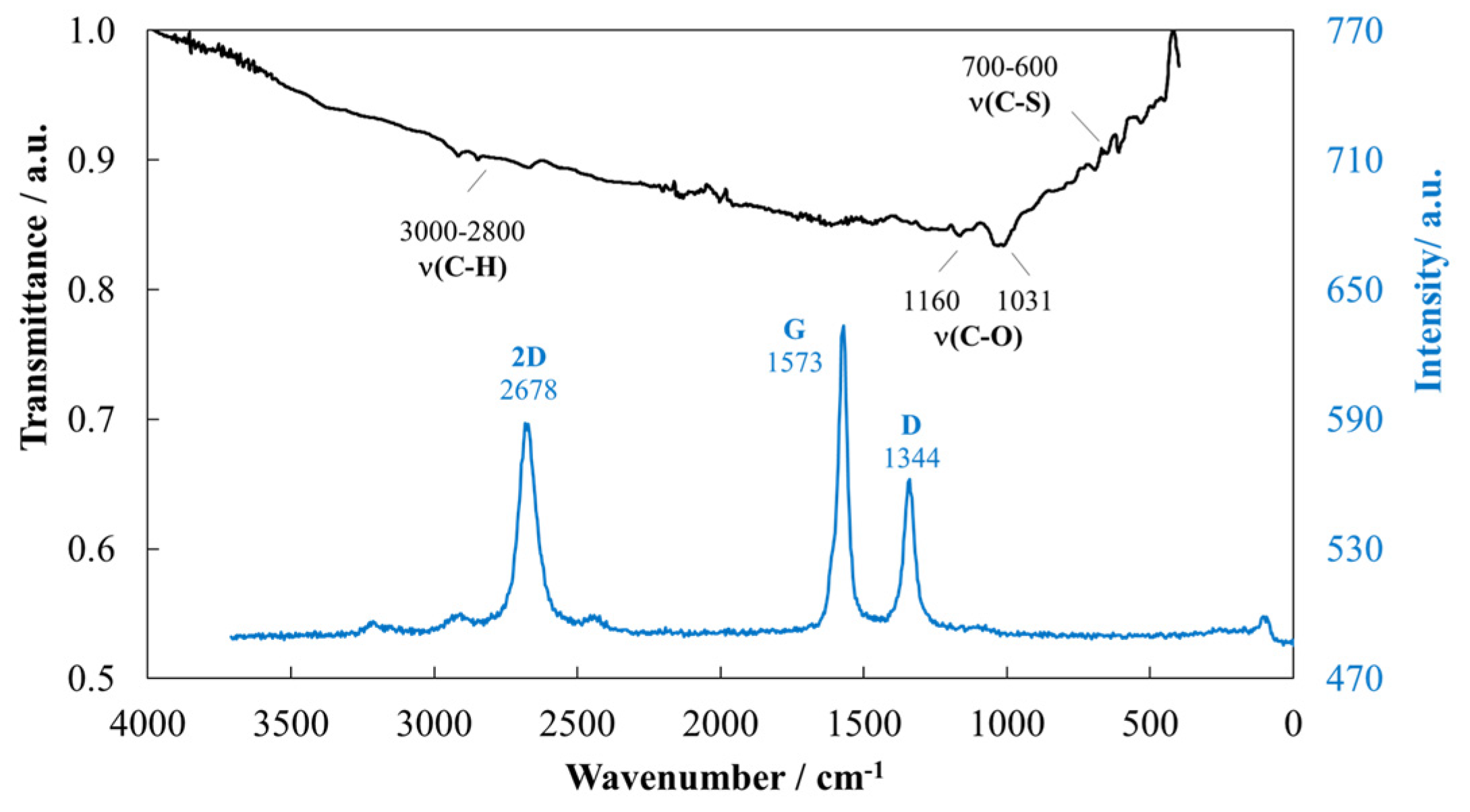



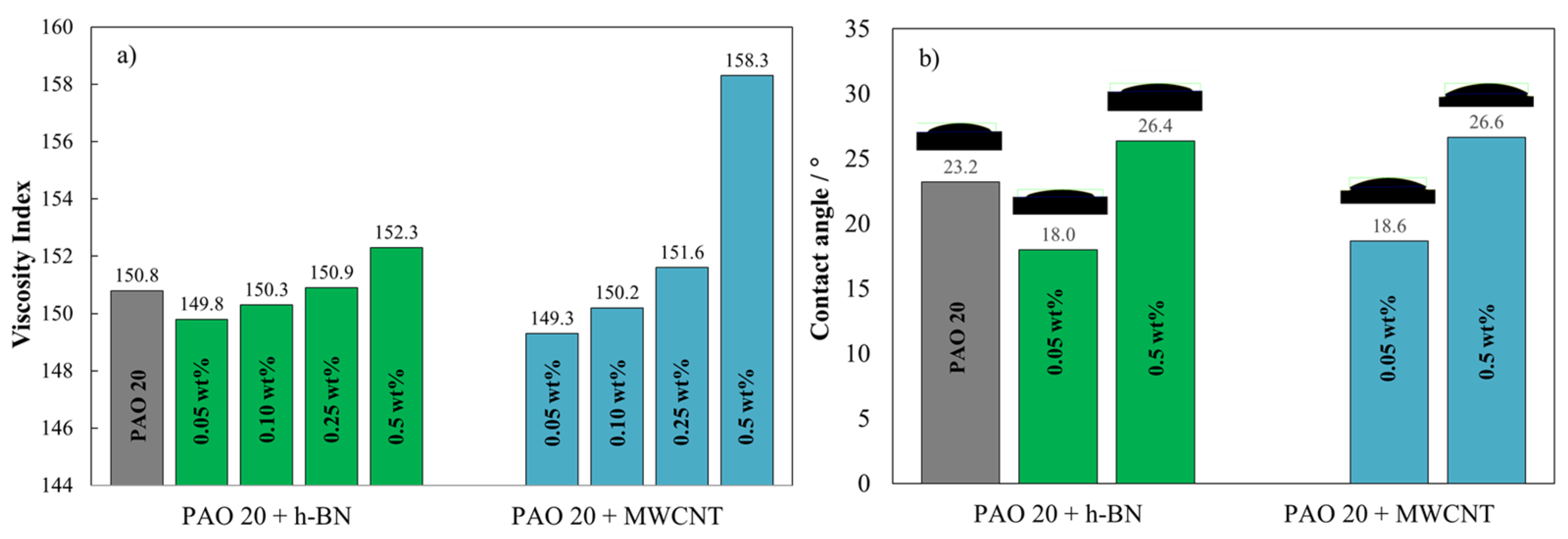



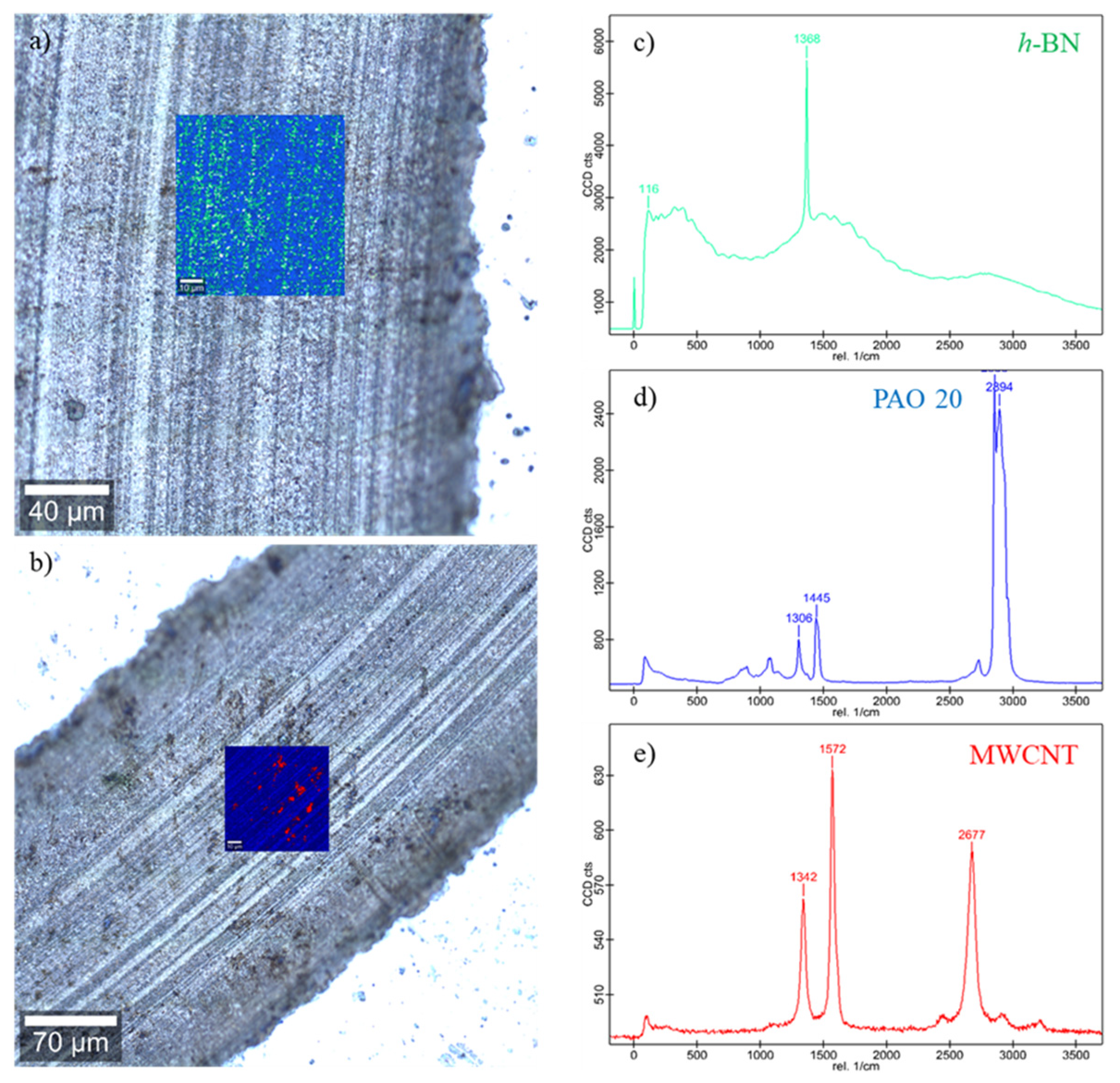
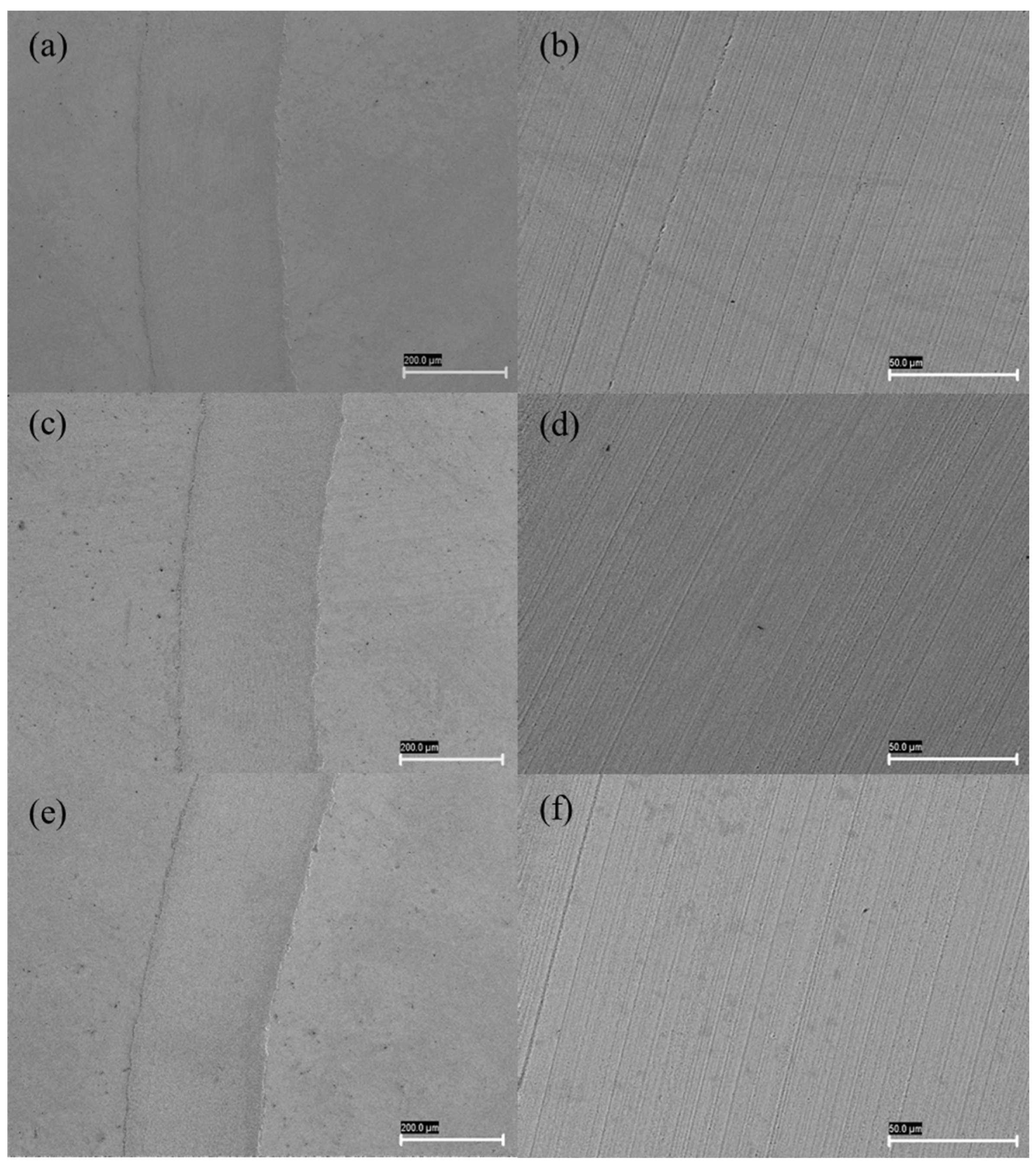
| Steel Discs | Steel Balls | |
|---|---|---|
| Material | AISI 52100 | AISI 52100 |
| Radius/mm | 5 | 3 |
| Ra/μm | 0.02 | 0.05 |
| Hardness | Hv30 190–210 | 58–66 Rockwell Scale |
| PAO 20 | 0.05 wt% | 0.1 wt% | 0.25 wt% | 0.5 wt% | |||||
|---|---|---|---|---|---|---|---|---|---|
| h-BN | |||||||||
| Ra/nm | σ/nm | Ra/nm | σ/nm | Ra/nm | σ/nm | Ra/nm | σ/nm | Ra/nm | σ/nm |
| 12 | 2 | 23 | 5 | 33 | 3 | 103 | 8 | ||
| MWCNTs | |||||||||
| 22 | 2 | Ra/nm | σ/nm | Ra/nm | σ/nm | Ra/nm | σ/nm | Ra/nm | σ/nm |
| 15 | 5 | 27 | 12 | 47 | 8 | 88 | 9 | ||
Disclaimer/Publisher’s Note: The statements, opinions and data contained in all publications are solely those of the individual author(s) and contributor(s) and not of MDPI and/or the editor(s). MDPI and/or the editor(s) disclaim responsibility for any injury to people or property resulting from any ideas, methods, instructions or products referred to in the content. |
© 2024 by the authors. Licensee MDPI, Basel, Switzerland. This article is an open access article distributed under the terms and conditions of the Creative Commons Attribution (CC BY) license (https://creativecommons.org/licenses/by/4.0/).
Share and Cite
Guimarey, M.J.G.; Villamayor, A.; López, E.R.; Comuñas, M.J.P. Performance and Antiwear Mechanism of 1D and 2D Nanoparticles as Additives in a Polyalphaolefin. Nanomaterials 2024, 14, 1101. https://doi.org/10.3390/nano14131101
Guimarey MJG, Villamayor A, López ER, Comuñas MJP. Performance and Antiwear Mechanism of 1D and 2D Nanoparticles as Additives in a Polyalphaolefin. Nanomaterials. 2024; 14(13):1101. https://doi.org/10.3390/nano14131101
Chicago/Turabian StyleGuimarey, María J. G., Antía Villamayor, Enriqueta R. López, and María J. P. Comuñas. 2024. "Performance and Antiwear Mechanism of 1D and 2D Nanoparticles as Additives in a Polyalphaolefin" Nanomaterials 14, no. 13: 1101. https://doi.org/10.3390/nano14131101






